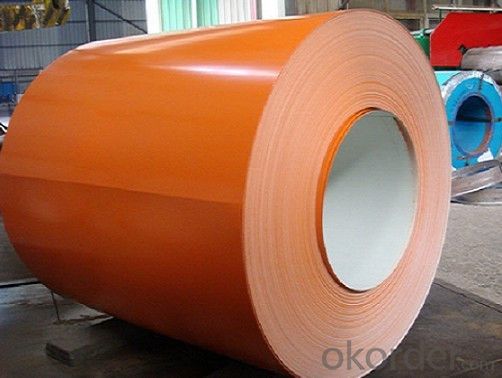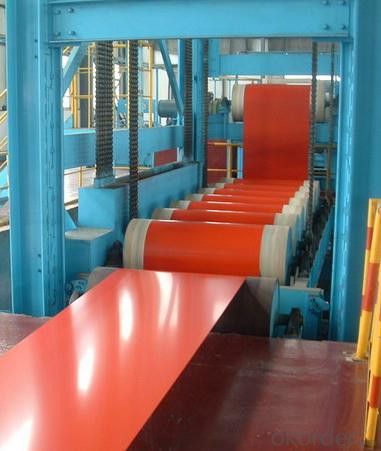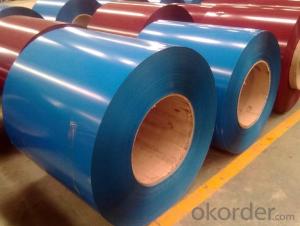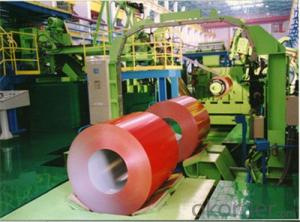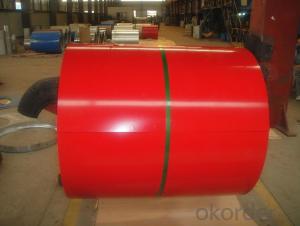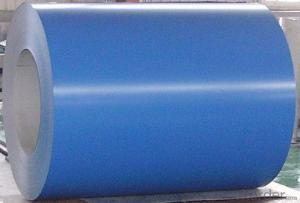Prepainted Aluminum Zinc Rolled Coil for construction
- Loading Port:
- Shanghai
- Payment Terms:
- TT OR LC
- Min Order Qty:
- 25 m.t.
- Supply Capability:
- 30000 m.t./month
OKorder Service Pledge
OKorder Financial Service
You Might Also Like
Structure of Aluminum Zinc Rolled Coil

Description of Aluminum Zinc Rolled Coil
Aluminum zinc coils is a kind of coated steel coil/sheet. With the cold rolled steel of different strength and thickness as substrate, it is produced through applying Al-Zn coat on both faces by hot dip process. In its coating, Al accounts for about 55%, Si 1.6%, while the remaining is Zn. Aluminum zinc coils enjoys both the physical protective feature and durability of Al and the electrochemical protective property of Zn. And its surface has bright silver color and regular embossed-like figure, which are highly decorative.
Main Feature of Aluminum Zinc Rolled Coil for Construction Roof
1.Corrosion resistance: It mainly depends on the aluminum protection. When the zinc being worn, the aluminum will form a dense layer of aluminum oxide, resist corrosion material to prevent further corrosion inside.
2. Heat resistance: Aluminum zinc alloy steel sheet has excellent heat resistance, can withstand high temperatures over 300 centigrade, and is similar with aluminized steel high temperature oxidation resistance. It often used in chimney pipes, ovens, fluorescent lighting device and the device cover.
3. Heat reflective: Galvanized steel plate heat-reflective high rate is twice as galvanized steel, often used to make insulation materials.
4. Economy: Because density of 55% AL-Zn is smaller than the density of Zn, so in the same weight and thickness of Galvanized zinc layer, aluminum-zinc steel plate is larger area more than 3% of galvanized steel sheet.
Applications of Aluminum Zinc Rolled Coil for Construction Roof
1. Construction and building: roofing; ventilating duct; handrail; partition panel;etc.
2. Electric appliance: refrigerator; washing machine; refrigerator; DVD;etc.
3.Transportation: oil tank; road sign; etc.
4.Agriculture:barn; etc.
5.Others:vending machine; game machine; etc.
Specifications of Prepainted Aluminum Zinc Rolled Coil for Construction
Chemical Composition | ||||||
GRADE | C | Si | Mn | P | S | Ti |
SGCC/DX51D+Z | ≤0.10 | ≤0.50 | ≤0.60 | ≤0.10 | ≤0.030 | ≤0.020 |
DX52D+Z | ≤0.10 | ≤0.50 | ≤0.60 | ≤0.10 | ≤0.030 | ≤0.020 |
SGCD/DX53D+Z | ≤0.10 | ≤0.30 | ≤0.50 | ≤0.05 | ≤0.030 | ≤0.020 |
SGCE/DX54D+Z | ≤0.10 | ≤0.30 | ≤0.30 | ≤0.03 | ≤0.020 | ≤0.020 |
DX56D+Z | ≤0.10 | ≤0.30 | ≤0.30 | ≤0.03 | ≤0.020 | ≤0.020 |
Structural | ≤0.20 | ≤0.60 | ≤1.70 | ≤0.10 | ≤0.045 | |
Mechanical Properties | ||||||
GRADE | Yield Strength MPa | Tensile Strength MPa | Elongation % | |||
SGCC(DX51D+Z) | ≥205 | ≥270 | - | |||
SGCD(DX53D+Z) | - | ≥270 | 38 | |||
SGCE(DX54D+Z) | - | ≥270 | 40 | |||
DX56D+Z | - | ≥270 | 42 | |||
FAQ of Prepainted Aluminum Zinc Rolled Coil for Construction
We have organized several common questions for our clients,may help you sincerely:
1. What is the minimum order quantity ?
Our MOQ is 50mt for each size. And we will consider to give more discount if you make big order like 1000 tons and more. Further more, the more appropriate payment term your offer the better price we can provide.
2. How long can we receive the product after purchase?
Usually within thirty working days after receiving buyer’s advance payment or LC. We will arrange the factory manufacturing as soon as possible. The cargo readiness usually takes 15-25 days, but the shipment will depend on the vessel situation.
3. How to guarantee the quality of the products?
We have established the international advanced quality management system,every link from raw material to final product we have strict quality test;We resolutely put an end to unqualified products flowing into the market. At the same time, we will provide necessary follow-up service assurance.
- Q: What are the different types of surface defects in steel coils?
- Some common types of surface defects in steel coils include scratches, pits, rust, scaling, laminations, and waviness.
- Q: explain what happen if carbon steel is exposed to an oxygen rich atmosphere at elevated temperature inside a furnace.
- Blowing oxygen or air rich in oxygen through molten carbon steel is a way of lowering the carbon content. The properties of carbon steel depend very much on the carbon content . too much and it is very brittle. It is all governed by a complex phase diagram. If the steel isn't actually melted, then only insignificant effects at the surface will occur.
- Q: So, I'm looking into steel toe paddock boots. I'll be using them around horses, horses that I don't know and that are rescue horses. I'm currently looking at Equitector the Moorland paddock boots. They're $200, and I think I have to order them online. I like boots that are this style (the Moorland style)... Is there any other brand of boots that has steel toe paddock boots, that are cheaper or that I can buy in stores?
- Hi! You can hike in steel toed boots, but I wouldn't. They aren't designed for hiking, no matter what the manufacturers says. They're built to protect your feet from hazards on a job site. I bought my first pair of decent hiking boots for $10/month on layaway at an outfitters. It took forever, of course, but I didn't have the money to buy them right out. Until then, I hiked in a pair of tennis shoes. Sneakers are just fine as hiking gear, though remember that you will have no ankle support, so you need to be more careful on rocky trails. Use a pair you don't mind getting dirty and make sure they have decent ankle support. Also, this is a great time of year to buy boots if you can scrounge the money together. Most outfitters are swapping over to their spring lines and have shoe/boot sales going on. You don't have to use an outfitter, either. Lots of regular shoe or department stores sell boots that will work just fine until you can afford some nice top-line boots.
- Q: How are steel coils used in the production of metal fencing?
- Steel coils are used in the production of metal fencing as they serve as the raw material for manufacturing the fence panels and posts. The steel coils are typically flattened, cut, and shaped into various components, such as wires or sheets, which are then assembled to create the final fencing product. The durability and strength of steel make it an ideal material for fencing, ensuring the fence's ability to withstand external forces while providing security and boundary demarcation.
- Q: I Don't have a Oxy act. torch but can Get a Propane one. The finished part(s) are .375 x .550 x .185
- *Hardening: okorder /... AISI 12L14 : Category :Steel Class :Carbon steel Type :Standard resulfurized and rephosphorized Common Names :Lead steel Designations: Germany: DIN 1.0718 Italy: UNI 9 SMnPb 23 Japan: JIS SUM 22 L , JIS SUM 24 L Sweden: SS 1914 United States: ASTM A108 , ASTM A29 , SAE J403 , SAE J412 , SAE J414 , UNS G12144 Composition : Element / Weight % C / 0.15 (max) Mn / 0.85-1.15 P / 0.04-0.09 S / 0.26-0.35 Pb / 0.15-0.35 Mechanical Properties : Properties / Conditions / T (°C) /Treatment Density (×1000 kg/m3) 7.7-8.03 / 25 Poisson's Ratio 0.27-0.30 /25 Elastic Modulus (GPa) 190-210 / 25 Tensile Strength (Mpa) 540 / 25 /cold drawn (round bar (19-38 mm)) Yield Strength (Mpa) /415 Elongation (%) /10 Reduction in Area (%) /35 Hardness (HB) 163 /25 /cold drawn (round bar (19-38 mm)) *Rod- 12L14 Case Hardened to Rockwell C 58-62 Case Depth .060 Sleeve - 12L14 Case Hardened to Rockwell C 58-62 Case Depth .060 Blade - 12L14 Case Hardened to Rockwell C 58-62 Case Depth .030 Quantity 5000 Rods: Weight per piece .8 ounce (Total 250 pounds) 5000 Sleeves: Weight per piece 1.8 ounce (Total 563 Pounds) 5000 Blades: Weight per piece .3 ounce (94 pounds) Total weight of RFQ 907 pounds 12L14 Steel.
- Q: What does INOX Steel means?I have been looking up the meaning but cannot find it... please help...
- Inox Steel
- Q: What is the accuracy of steel tape inspection?
- In addition, the project is through the detection of steel tape, steel tape each batch have the error him different, so do projects each into a batch of steel tape has to go through the inspection department, let this batch of steel tape has reached the same error range. All the measuring tools in this project are unified into these steel tape measures, so that the measurement error is guaranteed
- Q: What is the maximum temperature steel coils can withstand?
- The maximum temperature that steel coils can withstand varies depending on the specific grade and type of steel being used. Steel is known for its high heat resistance and can typically withstand temperatures ranging from 550°C to 1,100°C (1,022°F to 2,012°F), depending on the grade. However, it is important to note that prolonged exposure to high temperatures can cause steel to lose its structural integrity and result in permanent deformation or even failure. Therefore, it is crucial to adhere to the manufacturer's guidelines and specifications when determining the maximum temperature that steel coils can withstand in specific applications.
- Q: How are steel coils used in the manufacturing of suspension systems?
- Steel coils are used in the manufacturing of suspension systems as they provide the necessary support and cushioning for vehicles. These coils, also known as coil springs, are placed between the vehicle's chassis and the wheels to absorb impact and ensure a smooth ride. The steel coils are designed to compress and expand under the weight and movement of the vehicle, effectively absorbing shocks, vibrations, and uneven road surfaces. This helps to improve stability, handling, and overall comfort for the driver and passengers.
- Q: What are chemical properties of high speed steel? Physical properties?What is high speed steel used for? One interesting fact about high speed steel?
- wikipedia: High speed steel (often abbreviated HSS, sometimes HS) is a material usually used in the manufacture of machine tool bits and other cutters. It is often used in power saw blades and drill bits. It is superior to the older high carbon steel tools used extensively through the 1940s in that it can withstand higher temperatures without losing its temper (hardness). This property allows HSS to cut faster than high carbon steel, hence the name high speed steel. At room temperature, in their generally recommended heat treatment, HSS grades generally display high hardness (above HRC60) and a high abrasion resistance (generally linked to tungsten content often used in HSS) compared to common carbon and tool steels. see reference for more info .
Send your message to us
Prepainted Aluminum Zinc Rolled Coil for construction
- Loading Port:
- Shanghai
- Payment Terms:
- TT OR LC
- Min Order Qty:
- 25 m.t.
- Supply Capability:
- 30000 m.t./month
OKorder Service Pledge
OKorder Financial Service
Similar products
Hot products
Hot Searches
Related keywords



